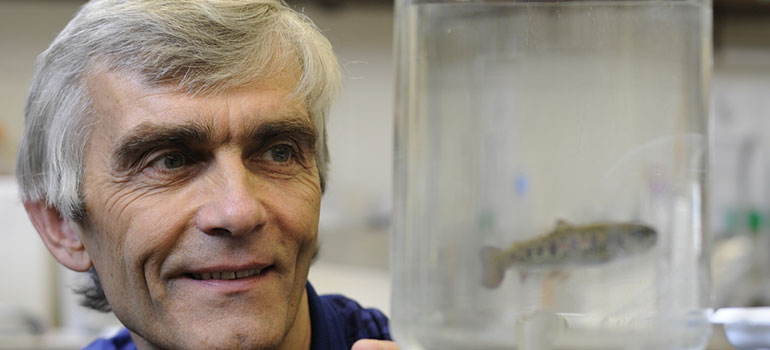The hot, dry weather is hard enough on people — but it’s even harder on sockeye salmon. As UBC biologist Tony Farrell explains, this year’s lack of snow melt coupled with record-high water temperatures mean sockeye salmon heading to the Fraser River to spawn might not make it at all.
What are ocean and river temperatures like for salmon at the moment?
It’s been particularly warm out in the Pacific Ocean this year, which means there’s a lot of hungry mackerel and tuna waiting to eat baby salmon as they migrate from the Fraser River to the Pacific in search of food. The mackerel and the tunas like the water a little warmer than the salmonids, so when warmer water moves north, as it does periodically, they follow. But because the Fraser River can’t move, it’s a bit like running the gauntlet for the salmon smolts.
The Fraser River is at historically low water levels and high temperatures for this time of the year. With very little snow pack across the province this year, the normal snowmelt has not happened. We’ve also had incredibly hot and dry conditions.
It’s low water and it’s hot water. As of July, the level of the Fraser River was at a 25-year minimum, and reliable records don’t go back beyond 25 years. The temperature has never reached 20.5 degrees Celsius this early in the year. On average, it would be four degrees cooler.
What effect do these factors have on salmon migration?
If you don’t have any water, you can’t swim. Small streams will be drying up, but we may not be into those sorts of problems for most of the salmon spawning habitats. Instead, the worry is that it may be too hot for them to swim upstream to spawn.
Sockeye salmon stocks appear to have tailored their swimming ability to swim up the Fraser River to a particular summer temperature and water flow. There’s a temperature at which salmon swim best. If the Fraser River is five to seven degrees Celsius above that particular temperature, they will not be able to get enough oxygen to their muscles to even swim.
Diseases also start taking over when the temperature is too hot. Normally, fish can tolerate a few scratches and cuts on their skin from predators attacking them or fishermen’s nets. But at high temperatures, fungus and bacteria proliferate. If fungus clogs the gills, the fish cannot breathe properly, making matters even worse.
Summer temperature in the Fraser River is so important, so it’s closely monitored. The Department of Fisheries and Oceans’ Environmental Watch Program warns that at 18 degrees Celsius, sockeye salmon have a decreased swimming performance. At 19 degrees they show early signs of stress and slowed migration. At 20 degrees they have high pre-spawn mortality and disease. And at 21 degrees it’s severe stress and early mortality. Right now, the temperature is sitting at around 20.5.
Is there a chance the sockeye won’t migrate at all?
How many sockeye turn up at the river is determined by how many sockeye salmon went out four years earlier and what their ocean survival was. The tuna and mackerel are likely affecting survival rates. Whether they make it up the Fraser River involves a series of separate questions:
- Have the salmon managed to store enough energy? Sockeye salmon stock stop feeding weeks before they reach the river and then they migrate up the river on an empty stomach gradually running down their “gas tank” of fat stores.
- Is the temperature right? I have heard that sockeye salmon are holding in the cooler Alberni Inlet on Vancouver Island because the temperature of Stamp Falls and Sproat River are in excess of 22 degrees Celsius. Salmon may be waiting for the temperature to cool down, but they cannot wait indefinitely, otherwise their “gas tank” will become too low for the migration.
Pacific salmon, including sockeye, spawn only once, so a successful river migration is critical. Typically, a salmon that makes it back to the river does a very good job of getting to the spawning area unless it’s captured or the conditions are bad. This year, it looks like the river temperature conditions are particularly bad for sockeye salmon. Right now the DFO is talking about the possibility of closing fisheries down to ensure that at least some salmon make it up to spawn.
Is there any hope on the horizon?
I think the good news is that nature always has surprises for us. We second-guess nature and very often we’re wrong. So let’s hope all the dire predictions are only partially wrong. What we do know is that some stocks of sockeye salmon tolerate higher temperatures than others. Will these stocks take over if other stocks fail? We don’t know. But if, as we suspect, there’s a potential for adaptation within the species, a key question is whether climate change is happening too fast for adaptational processes to take place. We don’t know the answer to that either, but UBC scientists are working on it.
VIDEO: Dr. Tony Farrell and BC salmon
